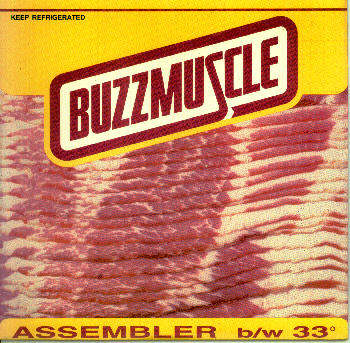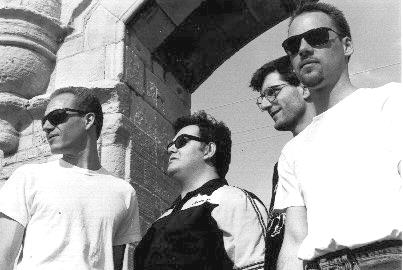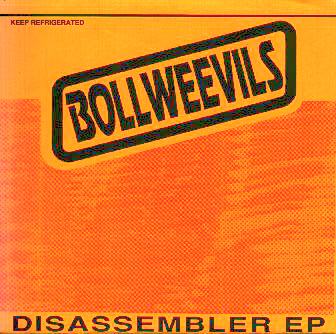Proper Display and Storage of your National
Treasure Buzzmuscle Assembler 7"
In 1997, the band Buzzmuscle had their record "Assembler" chosen to be part of the Mixing Messages design exhibition at the Cooper-Hewitt Design Museum,
and as a result the record became part of the permanent collection of the Smithsonian Institution. To commemorate this occasion, Buzzmuscle's founder Rob Warmowski
created this page, which lived on the website of Perishable Records for many years. At some point the Perishable site disappeared, as did this page. After Rob's untimely
passing, Buzzmuscle guitarist Greg Dunlap recovered it from the depths of the internet archive and gave it a new home. Other than a couple recent
updates and fixed links, all text and layout on this page is written by Rob unless otherwise specified. RIP friend.
 |
|
| Buzzmuscle "Assembler" b/w "33
Degrees" 7" Record. Design included in the Cooper Hewitt National Design Museum /
Smithsonian Institution in New York City. The exhibit, entitled Mixing Messages ran
in the winter of 1997. This website is a comprehensive list of everything you could
possibly wish to know about this record, its designers, band history and its long and odd
journey into National Treasure status. The record is
composed of a 2-color picture disk image 7" vinyl/plastic disk packaged in an
attractive, die-cut sleeve designed to invoke a package of Oscar Mayer brand bacon. The
die-cut windows on the packages backside invite you to "shop for the good one"
just like you would actual bacon. |
 |
Buzz...who?
 |
Buzzmuscle was a group of Chicago rock musicians whose
career together spanned the years 1991-4. Its members were Rob Warmowski (bass, yelping) Greg Dunlap (guitar, leaping) Brian Gay (guitar,
standing still) and Dave Schleitwiler (drums, flailing). They played numerous engagements
in and around the midwest, and recorded a total of three records. The pictured 7" is
their debut release. Like the vast majority of rock bands throughout the history of the
genre, their original music is today generally unknown and their impact was not widely
felt. |
| L to R: Brian Gay, Rob Warmowski, Greg Dunlap,
Admiral David A. Schleitwiler. Photo: Liz Clayton |
|
What...what the hell is this thing? It won't fit in my CD
player!
This thing is a vinyl record, seven inches in diameter. They
are played on a device known as a turntable, which spins at either 33 1/3 or 45
rpm, depending on the vinyl being played. You can try to put it in your CD Player, but
don't come crying to us afterwards.
Who designed this?
The "Assembler" single was conceived and designed
by Rob Warmowski. Greg Dunlap did the photography and mechanical work.
Mark Evans was responsible for letting us use
his Mac to do the scans and type and helping us out with our pathetic Photoshop skills.
Thanks, Mark. The logotype was done by hand courtesy of L. M. Owen, an illustrator of
world-class skill and artistry.
What do you mean, "National Treasure?"
The Buzzmuscle "Assembler" single was chosen to be
a part of the Mixing Messages exhibition, an
overview of contemporary graphic design. This show was produced by the Cooper-Hewitt
Museum, which is the Smithsonian Institution 's National Design Museum in New York City.
The record became a part of their permanent collection, joining other National Treasures
such as the Apollo 11 spacecraft, the original copy of the Constitution, and the moon
rocks. Its "National Treasure" status means that in 400 years, anthropology
students with access to the Smithsonian archives may be inspired by it to devote a bunch
of time exploring the Art of The Corporate Era, constructing rambling theses on the
"juxtapositions of late 20th Century art and commerce" and the "cult of
consumerism." Perhaps most importantly, as creators of National Treasure, the
designers are completely exempt from Federal Income Tax for the duration
of their lives.
How much did this cost to make?
Too much. In philosophy, we were a punk rock band, as we all
had punk rock pedigrees. Not one of us batted an eye at the idea of putting our own
money together to finance our records. The problem was, the production costs for the
diecuts and the picture disc took the project way over what a normal 7" would cost
and we felt we needed to get it out as quickly as we could. Not including recording or
photo costs, the project ended up costing approximately $3,100, much of which was
graciously loaned to us by our good friend and fantasy-bankroller Sean Campbell.
The manufacturing price led to the uncomfortable reality that
we did not want at the time to go to record distributors as ask for any more than $3.00
for a 7" single from an unknown band. It just seemed like a dumb thing to do. So we
sold them to distributors at a loss of a dime apiece. Punk rock.
How many of these were sold?
Of 1000 pressed, approximately 750 or so ended up getting
into stores after the distributors reluctantly did their job and placed them. We had heard
reports of the records being priced at as much as $9.00 retail on the East coast, which
was very annoying to discover.
What kind of band was Buzzmuscle?
Rob: "We were an aggressive rock band who didn't sound
like anybody in particular, but were compared to The Volcano Suns more than once. Other
than the fact that I can't really sing, I don't see the comparison. We wrote our own
music, and except for cover versions of "Eat Lead" by Breaking Circus, did not
stray from that repertoire. We all came from a fairly punk rock background; Dave
Schleitwiler's previous band was the Brookfield, IL hardcore band Bhopal Stiffs. Brian Gay
was an original member of one of the original American hardcore bands, Government Issue,
and was in later Chicago bands such as Savage Beliefs and The Watchmen. My previous band
was the Chicago surf/hardcore Defoliants and Greg Dunlap, while not from a band
previously, was directly responsible for the punk rock scene in DeKalb, IL during his
tenure as a student at Northern Illinois University, putting on many shows. We pursued our
music as an outlet for our creativity, and because playing tough, loud angry music is
never a mistake."
What other recordings exist?
 |
One year after the release of the Assembler
7", another 7" record , "Comedian / 12 Step" was released on
Perishable Records, the Chicago house label of the Sub Pop band Red Red Meat. If you follow the
link, you will see the faces of Tim Rutili and Ben Massarella, the only two people in the
entire tenure of Buzzmuscle to extend support for and belief in our music by releasing the
Comedian 7". We still appreciate it.('96) |
How did you get recognition from the Smithsonian
Institute?
Completely by accident. The curator of the exhibition at the
Cooper-Hewitt told us that in 1993, the staff began a search for pieces that were in
alignment with the show's theme of "Mixing Messages." Apparently, whoever was
conducting the search was using their noodle; instead of polling the art community in NYC,
they picked up the phone and began calling printers across the country. One such
printer was the North Carolina firm Barefoot Press, who did the printing and die-cut job
for the project. I understand the conversation went something along the lines of
"What have you done that's really cool lately?" "Well, there's this crazy
bacon sleeve..."
What are your thoughts about the music being forgotten
while the graphic design was honored?
Greg: "I feel its better than not being remembered at
all. The aesthetics of making records has been largely forgotten in this day and age, but
in a prefect world, the design and the music should go hand in hand. Its nice to have any
part of your efforts recognized."
Rob: "Both the music and the design were purely creative
efforts, pursued with equal attention. That the design is recognized while the music isn't
is probably a function of volume; there's enough independent rock music to serve every
excruciating niche and fetish on the planet ten times over, yet the vast majority of
graphic design is commissioned by commercialists who have no intrinsic interest in the
artwork, so most of it is a total bore that just mushes together and we stood out in
context. Either that, or we sucked or something."
If I wanted you guys to design something for my company,
what would I have to do?
Greg: "Come up with an idea actually worth doing and
boatloads of money."
Rob: "We don't really know how to behave when placed in
corporate design situations, so if you do come to us with a proposal, please make sure the
end-client is incapable of locating and annoying us."
How do I properly display and store my National Treasure
Buzzmuscle 7"?
The cardinal rule of displaying your Buzzmuscle single is
that the bacon must be horizontal. When displayed horizontally, the bacon shows
through the window properly as normal bacon would. You should also make sure none of the
type present on the disc shows in the window, spoiling the effect. When your single
has become worn or soiled, it should be framed and hung on the wall in a prominent
location, as its National Treasure status accords. At no time is the record to
touch the ground.
 |
This animation shows the proper
alignment of the picture disc. Note the radial rotation before insertion. Display without proper alignment may be a violation of The
National Treasure Preservation Act of 1921, a little known Federal statute that affords
protections to items designated National Treasures similar to those extended the Flag of
the United States. |
What are the lyrics to the songs / what are they about?
Rob: "Assembler" was a series of lyrical images
that connected to create a kind of diorama for the stuff on my mind at the time, mostly
stuff about how age and experience carries with it automatic dismissal by a large segment
of people. That segment is us classically known as "the kids", but I had in mind
a broader segment, a segment characterized by do-nothing or know-nothing adults who never
adopted any sense of responsibility or forethought in their lives. I was kind of drawing a
line between those who do and those who watch, and musing over the baggage each side
carries. Brian, our guitar player didn't like the "mighty white of you" refrain
too much at first, and I kind of see why, but I recall he relented when he noticed that I
was going more for a grizzled old grandfather approach with a euphemism rather than
calling for a race war or whatever."
Destiny took Dan away from the pages of his Mad Magazine
today
To streets lined with formaldehyde everything changes
while its stays the same so
Dan got himself a nickel-plated ride and motored right
over to the man with the mission
And for his trouble got a nice fat cuban cigar
Mighty white of you to tell me what I should do a wetnose
punk like you's got all the answers
The man with the plan said thus to Dan / a gold and
chrome Zippo appeared in his hand
He nodded his head / pretending to understand
"I got a wife in the coop, I got a flag on my lawn,
I got a couple of kids and a case of gin
and that my friend, is everything you gotta know"
Mighty white of you etc...
Assembler eats power and sweats what we need
Eroder eats hours and doesn't do a goddamned thing
Rob: "33 Degrees was a poke through a real fetish of
mine, the Freemasons. The title is a reference to
that organization's supposedly highest order, that of 33rd Degree Mason. The idea that a
clandestine group of decrepit, fez-prone caucasians run the planet in secret is fun to
consider for a minute or two, and this was written during that minute. I heard much later
from Jay Robbins of the very swell DC rock band Jawbox that he had also written a song
about the Freemasons and had called it 33 Degrees as well, but had shelved it. My bass at
the time also had a faux-chrome Masonic symbol on it. The only time I ever got any
feedback on it was from a guy at a gig in Champaign, IL, who asked me if I was a
"brother of the craft." I felt like a dope when I told him I was just a
dabbler."
Theory conspiracy and its a damn good thing these guys
are friendly
All they want is what they've had for years
Anything you wanna hide
better stash it in plain sight and double-check the
greenback in your pocket, Jackson
Brothers of the Craft have got your number
No, I never would have guessed that a bunch of fat old
men
Pull the strings that jerk you under
Asked the man and he lied about what he had to know
Hustlers swing that smoky ball and wring their hands in
holy terror
At every mention of the brotherhood
Chessmen for sale is ancient history / the ring of truth
is doubleplusungood
Pull slack, watch your back
Open the forbidden Cliff Notes and try a little sympathy
for things obscure
Know I never would have guessed nobody's watching the
Watchmen
What happened to the bacon after you shot the photographs?
We ate the hell out of it. Enjoyed it, too. Made
sandwiches, I think.
What are the guys from Buzzmuscle doing today?
Greg Dunlap is employed as a fast-talking nerd and has not played music for some time. He lives in Portland, OR with his wife Nicole and a small menagerie of animals.
Brian Gay is
living in the Chicago area where he works as a developer at a company making educational web applications.
Dave Schleitwiler is a retired mechanic and automotive instructor. He lives in Englewood, CO where he
owns Sunnyside Recording Studio.
Rob Warmowski died suddenly on August 31, 2019 at the age of 52. He is greatly missed by all his friends and family.
I bought one of these! What's it worth?
Hell, I dunno. Ask a collector. If you are a collector, tell us what you think they're worth, because
we have a few dozen left. Don't forget: they're National Treasures.
What does Oscar Mayer
have to say about all this?
It is unclear at this time if any representatives from the
meatpacking giant have seen the record. Now that the Chicago Tribune has run a piece on
its inclusion in the New York exhibit, it will probably make a company lunchroom bulletin
board. Guys, if you're reading this, we don't have any money.
Where have I seen this before?
When the record was released in January of 1992, it was sent
to approximately 60 press addresses. The only coverage we received that we are aware of
was in a local zine called Speed Kills ("okay, I guess") Alternative
Press ("good songwriting") and, amazingly, Madameoiselle ("like,
wow".) It's entirely possible that it appeared or was reviewed in other publications,
but none of us are aware of them, and what's more, we don't even have a copy of the
Madamoiselle. If anybody does, tell us please.
Rob: "This record also inspired a clone of its design.
In late '92, a teen suburban Chicago hardcore band called the Bollweevils released a
7" entitled "Disassembler", whose cover was a poor knockoff of our own
high-quality Oscar Mayer bacon package knockoff and whose liner notes scolded "Thanks
to Buzzmuscle for reminding us that a great package does not necessarily make a great
record." Years later, I ran into a member of that band on the Internet and asked what
exactly would cause one puny, unheard-of band to waste an entire cover art opportunity on
insulting another puny, unheard-of band's work. The answer came back: I had insulted them
for not being punk rock enough at a show we played. Kids crack me up."
Greg: I remember walking into Reckless Records one day, and
Charlie (who ran the place at the time) sort of looked at me funny and said "Hey
there." I was sorta confused and waved, and started walking back towards the singles.
I notice he has his eye on me the whole time I'm walking back, like he thinks I'm going to
rip something off. When I turned the corner to the bin where the new singles were, it was
sitting up on display and I just about wet my pants. I wasn't pissed, I always thought
imitation was the highest form of flattery. I laughed my ass off. I look up, and Charlie
is just smiling at me, nodding his head. I bought one immediately and brought it to
practice that very night. Everyone was amazed and got a big chuckle over it.
 |
Bollweevils "Disassembler"
7". Woe unto you who would anger The Youth. |
Thank you for you interest in this record and its
historical context. If you'd like to contact us, feel free to send email. Thanks to David Rothschild for the
Chicago Tribune Homefront column inclusion. This page was initially published January 2,
1997 and was last updated September 9, 2019.





